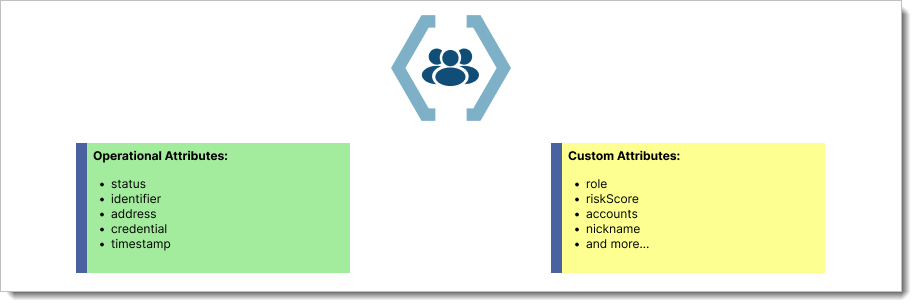User entity reference
Understand how user entities work in SecureAuth and what each attribute controls for authentication and access management.
💡 Why this matters
User entities determine how authentication works, what data gets stored, and how you can manage users across your applications.
What is a user entity
A user entity contains all the information SecureAuth stores about an individual user. This includes operational attributes that control authentication flows and optional custom attributes for your business needs.
Two types of attributes:
- Operational attributes - Required by SecureAuth for authentication and user management
- Custom attributes - Optional fields you define for business requirements

Operational attributes
These attributes control how SecureAuth handles authentication and user management.
Status
Controls what actions a user can perform in your system.
| Status | What it allows | When to use |
|---|---|---|
| new | Account activation only | New user registrations |
| active | Full authentication | Normal operational users |
| inactive | No authentication | Suspended or temporary users |
| deleted | No actions | Archived users |
Status flow rules:
- Only
newusers can complete account activation - Only
activeusers can authenticate - Administrators can change any user to
inactiveornew
Identifiers
Unique keys that identify users during authentication and API calls.
| Identifier Type | Format | Example | Use Case |
|---|---|---|---|
| Valid email format | user@company.com | Email-based login | |
| mobile | E164 format | +12345678901 | SMS authentication |
| uid | ASCII characters | user123 | Custom username |
| external | ASCII characters | emp_987654 | Integration with HR systems |
Key rules:
- Each identifier must be unique within a user population
- Users can have multiple identifiers of different types
- Identifiers serve as authentication usernames
Addresses
Contact information for verification codes and account recovery.
| Address Type | Format | Verification Required | Purpose |
|---|---|---|---|
| Valid email | Optional | Password reset, notifications | |
| mobile | E164 format | Optional | SMS codes, alerts |
Verification states:
- Verified addresses - Unique per population, used for account recovery
- Unverified addresses - Can be shared between users, limited functionality
Address rules:
- Verified addresses can only belong to one user per population
- Unverified addresses can be shared between users
- Address verification prevents account takeover
Credentials
Authentication methods stored for each user.
| Credential Type | Description | User Limit |
|---|---|---|
| password | Encrypted password hash | One per user |
| webauthn | FIDO2/WebAuthn keys | One per user |
Security notes:
- Users can have multiple credential types simultaneously
- Only one password and one WebAuthn credential per user
- Credentials are encrypted and cannot be retrieved in plain text
Timestamps
Track user account activity and changes.
| Timestamp | Tracks | Administrative Use |
|---|---|---|
| created_at | Account creation | Audit trails, compliance |
| updated_at | Last profile change | Monitoring user activity |
| status_updated_at | Status changes | Security investigations |
Custom attributes
Add business-specific data fields to user entities for your organization's needs.
Common examples:
- Employee ID
- Department
- Role or permissions
- Account numbers
- Risk scores
⚠️ Security note
Avoid storing sensitive data like SSNs or payment information in custom attributes
Next step: Define custom user attributes →